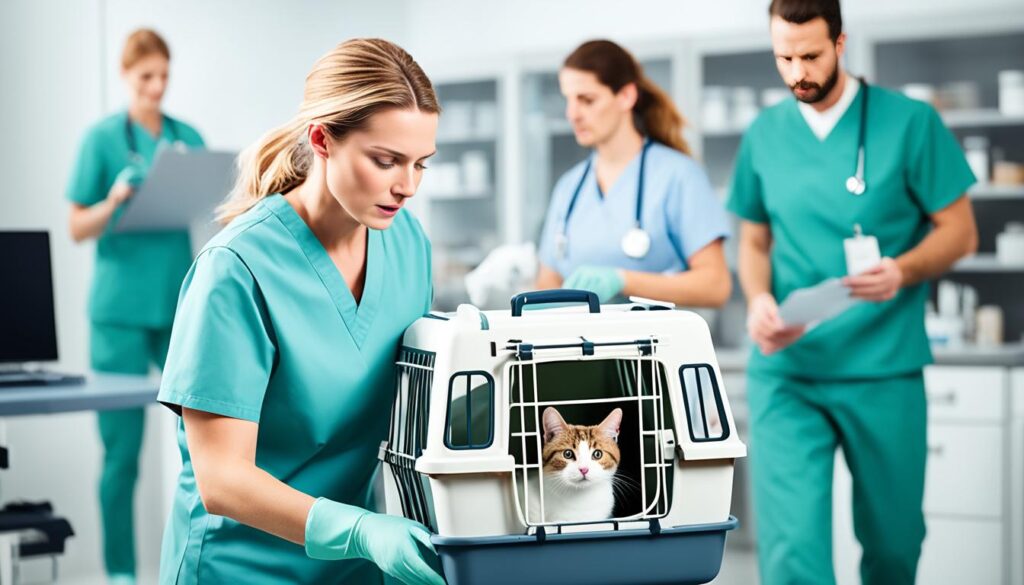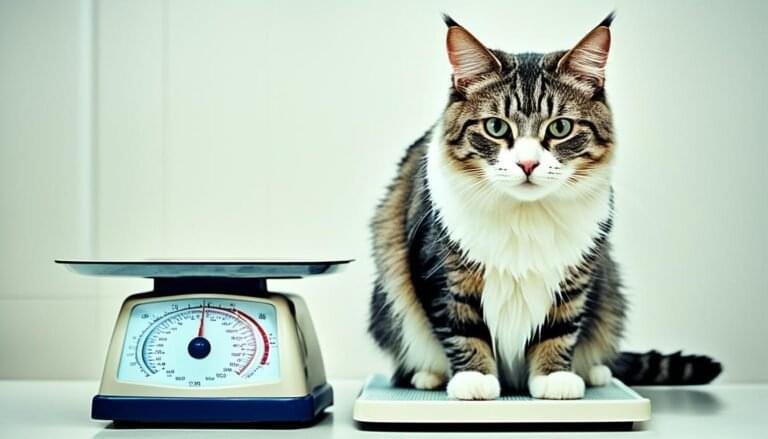Did you know that cats can develop fevers just like humans? It’s true! Fever in cats can indicate an underlying health problem and it’s essential to be able to recognize the symptoms. As a cat owner, knowing how to tell if your cat has a fever and understanding the importance of monitoring their health is crucial for their well-being. In this article, I will guide you through the signs of fever in cats, how to check your cat’s temperature, the causes of fever, and what to do if your cat is running a fever. Let’s dive in!
Key Takeaways:
- Recognizing the signs of fever in cats is important for early detection of illness.
- Checking your cat’s temperature can help confirm if they have a fever.
- Fever in cats can be caused by various factors, including infections, injuries, and certain medications.
- Seeking prompt veterinary care is crucial when your cat has a fever to determine the underlying cause.
- Maintaining a healthy cat lifestyle and taking preventive measures can help prevent fevers and promote overall well-being.
Signs of Fever in Cats
Cats exhibit various signs when they have a fever. These signs can help you determine if your cat is sick and in need of veterinary care. Here are the common signs of fever in cats:
- Warm ears: Feel your cat’s ears. If they feel warmer than usual, it may indicate a fever.
- Dry nose: Check your cat’s nose. If it is dry and warm, it can be a sign of fever.
- Lethargy: Is your cat unusually tired and lacking energy? This could be a symptom of fever.
- Loss of appetite: A decreased desire to eat is a common sign of illness, including fever.
- Glassy eyes: If your cat’s eyes appear dull or glassy, it may be a result of fever.
- Elevated temperature: Use a pet thermometer to check your cat’s temperature. A rectal temperature above 103.5 degrees Fahrenheit is considered a high fever.
Monitoring these symptoms can help you determine if your cat is running a fever. If you notice any of these signs, it’s important to consult with a veterinarian for a proper diagnosis and treatment. Prompt veterinary care is crucial to ensure your cat’s health and well-being.
| Signs of Fever in Cats | Explanation |
|---|---|
| Warm ears | Feel warm to the touch |
| Dry nose | Nose feels dry and warm |
| Lethargy | Unusual tiredness and lack of energy |
| Loss of appetite | Decreased desire to eat |
| Glassy eyes | Eyes appear dull or glassy |
| Elevated temperature | Rectal temperature above 103.5°F |
Checking Your Cat’s Temperature
Taking your cat’s temperature is an important part of determining if they have a fever. By checking their temperature, you can gather vital information about their health status. Cats cannot tell us how they’re feeling, so monitoring their temperature is crucial in identifying potential issues.
So, how do you check your cat’s temperature? The most accurate way is by using a thermometer designed for pets. A rectal temperature reading provides the most reliable results.
To check your cat’s temperature:
- Prepare a rectal thermometer and a lubricant specifically made for veterinary use.
- Gently position your cat, ensuring they are calm and cooperative.
- Apply a small amount of lubricant to the thermometer’s tip to make insertion easier and more comfortable for your cat.
- Lift your cat’s tail and insert the thermometer into their rectum, ensuring it goes in about 1 to 1.5 inches. Do not force it.
- Hold the thermometer in place for about one minute or until it beeps, indicating that the temperature has been recorded.
- Remove the thermometer, clean it properly, and note down the temperature reading.
A cat’s normal body temperature ranges from 100.5 to 102.5 degrees Fahrenheit (38.0 to 39.2 degrees Celsius). Anything higher than 103.5 degrees Fahrenheit (39.7 degrees Celsius) is considered a high fever and requires immediate veterinary attention.
Regularly checking your cat’s temperature can help you detect any potential health issues early on and ensure they receive the appropriate care. If you are unsure about how to take your cat’s temperature or if your cat becomes stressed during the process, it’s best to consult your veterinarian for assistance.
Normal Cat Body Temperature
| Temperature | Description |
|---|---|
| Less than 100.5°F (38.0°C) | Below normal |
| 100.5°F to 102.5°F (38.0°C to 39.2°C) | Normal |
| 102.6°F to 103.4°F (39.2°C to 39.7°C) | Mild fever |
| 103.5°F and above (39.7°C and above) | High fever |
Causes of Fever in Cats
Fever in cats can be caused by various factors, including bacterial or viral infections, injuries, certain medications, and even tumors. Understanding the underlying cause of the fever is important for proper treatment and management.
While cats may develop a fever as a response to infection or injury, it can also be a symptom of an underlying medical condition. Here are some common causes of fever in cats:
- Bacterial Infection: Infections caused by bacteria such as urinary tract infections, respiratory infections, and abscesses can lead to fever in cats. These infections can be localized or systemic, affecting different parts of the body.
- Viral Infection: Viral infections, including feline respiratory viruses and feline leukemia virus, can cause fever in cats. These infections are highly contagious and can be transmitted through direct contact with an infected cat or contaminated objects.
- Injury: Trauma or injury resulting from accidents, falls, or fights with other animals can cause fever in cats. Inflammatory responses to tissue damage can lead to an elevated body temperature.
- Certain Medications: Some medications, such as certain antibiotics or vaccines, can cause fever as a side effect in cats. It is important to monitor your cat’s temperature after administering any new medication.
- Tumor: In some cases, a fever in cats can be associated with the presence of a tumor. Tumors can trigger an immune response, leading to an increase in body temperature.
Identifying the cause of fever in your cat is crucial in determining the appropriate treatment. If your cat has a persistent or high fever, it is recommended to consult with a veterinarian for a thorough examination and diagnosis.
A veterinarian will be able to conduct necessary tests to identify the underlying cause and develop an appropriate treatment plan. They may recommend blood tests, imaging studies, or additional diagnostic procedures to investigate the specific cause of the fever.
Treating the underlying cause of the fever is essential for managing your cat’s health and alleviating their discomfort. With prompt veterinary care and accurate diagnosis, you can help your cat recover and prevent any potential complications.
Recognizing Fever Symptoms in Cats

Fever in cats can exhibit a variety of symptoms that are important to recognize in order to provide appropriate care. By being observant and attentive to changes in your cat’s behavior and physical condition, you can effectively identify potential fever symptoms. Here are some key indicators to look out for:
- Lack of Appetite: A decrease in your cat’s interest in food or a significant reduction in their usual eating habits.
- Decreased Energy Levels: Noticeable lethargy or a lack of usual activity and playfulness.
- Decreased Grooming: A decline in your cat’s grooming routine, resulting in a less clean and tidy appearance.
- Increased Heart Rate: A faster than normal heart rate, which can sometimes be felt by placing your hand gently on your cat’s chest.
- Dehydration: Symptoms include dry and sunken-looking eyes, dry gums, and a loss of skin elasticity. You can test for dehydration in cats by lightly pinching and then releasing the skin on the back of their neck; if it takes longer than usual to return to its original position, it may indicate dehydration.
- Shivering: Visible trembling or shivering, especially if your cat is seeking warmth or attempting to curl into a smaller position.
If you observe one or more of these symptoms in your cat, it’s important to monitor their condition closely and consider consulting a veterinarian for further evaluation and guidance. Additionally, these symptoms can serve as a valuable reference point when communicating your observations to the veterinarian, aiding in the accurate diagnosis and treatment of your cat’s fever.
Example of a Table:
| Symptom | Significance |
|---|---|
| Lack of Appetite | Indicates reduced interest in food and potential systemic illness |
| Decreased Energy Levels | Suggests low vitality and possible infection |
| Decreased Grooming | Reflects a decline in self-care and potential discomfort |
| Increased Heart Rate | Can be a sign of physiological stress and potential illness |
| Dehydration | Indicates inadequate fluid intake and possible underlying health issues |
| Shivering | Usually indicates discomfort, low body temperature, or pain |
It’s important to note that while recognizing these symptoms is valuable, a professional veterinary assessment is necessary for an accurate diagnosis. Prompt attention and proper care can ensure a swift recovery and safeguard the overall health and well-being of your beloved feline companion.
What to Do If Your Cat Has a Fever
If your cat has a fever, it’s important to seek veterinary care. A veterinarian can provide a proper diagnosis and prescribe appropriate treatments. In the meantime, it’s essential to keep your cat hydrated and provide a comfortable environment for them to rest.
Veterinary Care: When your cat has a fever, it’s crucial to consult a veterinarian. They can perform a thorough examination, conduct tests if necessary, and determine the underlying cause of the fever. Prompt veterinary care ensures that your cat receives the proper treatment, addressing any potential health issues.
Hydration: Keep your cat well-hydrated to support their recovery. Offer fresh water at all times and encourage them to drink by using a clean, shallow dish. Additionally, you can try offering wet food to increase their fluid intake. Adequate hydration helps maintain your cat’s overall well-being and aids in the treatment of fever.
Comfortable Environment: Create a calm and comfortable space for your cat to rest while they recover from the fever. Provide a soft and cozy bed, away from drafts and excessive noise. Ensure the room temperature is moderate and maintain a peaceful atmosphere to help reduce stress. A comfortable environment promotes healing and supports your cat’s well-being.
If your cat has a fever, remember to seek veterinary care, keep them hydrated, and provide a comfortable environment. Taking these steps will aid in their recovery and ensure their overall health and well-being.
Importance of Prompt Veterinary Care

Prompt veterinary care is crucial when your cat has a fever. Fever can be a sign of underlying conditions that need to be addressed. In some cases, a fever may be classified as a “fever of unknown origin” (FUO) if the cause cannot be determined immediately. Working closely with a veterinarian ensures that your cat receives timely and appropriate treatment.
| Benefits of Prompt Veterinary Care |
|---|
| 1. Early diagnosis and treatment of underlying conditions |
| 2. Prevention of complications |
| 3. Improved chances of recovery |
| 4. Expert guidance and support |
When your cat shows signs of fever, such as elevated body temperature and other symptoms, it is vital to seek immediate veterinary care. A veterinarian can conduct a thorough examination, perform diagnostic tests, and recommend appropriate treatments to address the underlying cause of the fever. Early intervention can prevent the progression of underlying conditions and potentially save your cat’s life.
Furthermore, some fevers in cats may fall under the category of “fever of unknown origin” (FUO), where the cause of the fever is not immediately apparent. This can be a challenging situation for both the owner and the veterinarian. In such cases, prompt veterinary care becomes even more critical, as it allows for close monitoring and further investigation to identify the underlying condition causing the fever.
By seeking prompt veterinary care, you are ensuring that your cat receives the necessary medical attention and treatment. It is important to remember that fevers in cats should not be taken lightly, as they can indicate serious health issues. Always consult a veterinarian to determine the best course of action for your cat’s well-being.
Preventive Measures for Cat Health
Taking preventive measures is vital for maintaining your cat’s health. By implementing these measures, you can help prevent various illnesses and reduce the likelihood of your cat running a fever. Some of the key preventive measures for cat health include:
Scheduling Regular Check-ups
Regular veterinary check-ups are essential for monitoring your cat’s overall health and detecting any potential issues early on. During these check-ups, the veterinarian can assess your cat’s condition, administer necessary vaccines, and provide preventive treatments. Check-ups should be scheduled at least once a year or as recommended by your veterinarian.
Ensuring Vaccinations are Up to Date
Vaccinations play a vital role in protecting your cat from various infectious diseases. By keeping your cat’s vaccinations up to date, you can help strengthen their immune system and reduce the risk of illness. It’s important to follow the recommended vaccination schedule provided by your veterinarian.
Providing Proper Parasite Prevention Measures
Parasites, such as fleas, ticks, and worms, can pose significant health risks to your cat. Implementing effective parasite prevention measures is crucial for ensuring your cat’s well-being. This includes using flea and tick preventatives, administering regular deworming treatments, and keeping your cat’s environment clean and free from pests.
| Preventive Measure | Benefits |
|---|---|
| Scheduling Regular Check-ups | Early detection of health problems Appropriate preventive treatments |
| Ensuring Vaccinations are Up to Date | Prevention of infectious diseases Stronger immune system |
| Providing Proper Parasite Prevention Measures | Reduced risk of parasite-related illnesses Improved overall health and well-being |
By incorporating these preventive measures into your cat’s healthcare routine, you can help safeguard their health and minimize the chances of them developing a fever. Remember, regular check-ups, vaccinations, and parasite prevention are key to promoting a long and healthy life for your beloved feline companion.
Maintaining a Healthy Cat Lifestyle
As a responsible cat owner, it’s important to prioritize your feline companion’s well-being. Maintaining a healthy cat lifestyle not only contributes to their overall happiness but also helps prevent the development of health issues, including fevers. By providing a balanced diet, encouraging exercise, reducing stress, and practicing good hygiene, you can help ensure that your cat enjoys a long and fulfilling life.
1. Balanced Diet
Feeding your cat a balanced diet is essential for their overall health. Opt for high-quality cat food that meets their specific nutritional needs. Consult with your veterinarian to determine the right type and amount of food for your cat, considering factors such as age, weight, and any medical conditions. It’s also important to provide fresh water at all times to keep your cat hydrated.
2. Exercise
Just like humans, cats also need regular exercise to stay healthy and maintain a healthy weight. Engage your cat in interactive play sessions using toys or laser pointers to encourage physical activity. Set aside time each day for play and exercise, keeping in mind that cats have different activity levels and preferences. Consult with your veterinarian to determine the appropriate exercise routine for your cat’s specific needs.
3. Stress Reduction
Cats are sensitive creatures, and stress can have a negative impact on their health. Create a calm and stress-free environment for your cat by providing them with a designated space where they can retreat and relax. This can be a cozy bed, a quiet room, or a cat tree. Additionally, establish a consistent daily routine to help reduce stress and provide a sense of security for your cat.
4. Hygiene
Good hygiene practices play a crucial role in maintaining your cat’s health. Regularly groom your cat by brushing their fur to remove loose hair and prevent matting. Additionally, ensure that their litter box is clean and easily accessible. Regularly clean and disinfect their food and water bowls to prevent bacterial growth. Maintaining proper hygiene not only keeps your cat comfortable but also reduces the risk of infections and other health issues.
By following these guidelines and incorporating them into your cat’s daily routine, you can help create a healthy and happy lifestyle for your feline friend. Remember to consult with your veterinarian for personalized advice and recommendations based on your cat’s specific needs. With proper care and attention, you can provide the foundation for a thriving and fever-free life for your beloved companion.
Conclusion
Detecting cat fever is crucial for maintaining your cat’s health. By recognizing the symptoms of fever and seeking prompt veterinary care, you can ensure that your cat receives the appropriate treatment they need. Monitoring your cat’s health on a regular basis, implementing preventive measures, and promoting a healthy lifestyle all contribute to their overall well-being.
Remember to consult with a veterinarian for a proper diagnosis and guidance. They have the expertise to accurately detect cat fever and provide the necessary care for your furry friend. Regular veterinary check-ups, vaccination, and parasite prevention are essential in maintaining cat health and reducing the chances of a fever.
Take the necessary steps to create a healthy environment for your cat. This includes providing a balanced diet, encouraging exercise, minimizing stressors, and practicing good hygiene. A thriving cat lifestyle with these components can bolster their immune system and decrease the likelihood of them developing a fever.
Stay vigilant and observant of your cat’s health. Prompt action is key when it comes to identifying and addressing cat fever. By being proactive in detecting symptoms and seeking veterinary care, you are actively safeguarding your cat’s well-being and ensuring they live a happy, healthy life.
FAQ
How can I tell if my cat has a fever?
How do I check my cat’s temperature?
What are the causes of fever in cats?
What are the symptoms of fever in cats?
What should I do if my cat has a fever?
Why is prompt veterinary care important for fever in cats?
What preventive measures should I take for my cat’s health?
How can I maintain a healthy lifestyle for my cat?
How important is it to detect cat fever?
References
| International Cat Association (TICA) | https://www.tica.org/ |
| The Cat Fanciers’ Association (CFA) | https://cfa.org/ |
| World Cat Federation (WCF) | https://www.wcf-online.de/ |
| Fédération Internationale Féline (FIFe) | https://www.fifeweb.org/ |








[…] can significantly impact a cat’s overall health and well-being. Detecting and managing this condition is crucial for the cat’s quality of life. Understanding the signs and underlying causes of hyperthyroidism is essential in […]